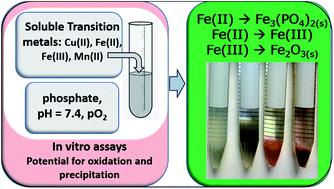当前位置:
X-MOL 学术
›
Environ. Sci.: Processes Impacts
›
论文详情
Our official English website, www.x-mol.net, welcomes your feedback! (Note: you will need to create a separate account there.)
Fate of transition metals in PO4-based in vitro assays: equilibrium modeling and macroscopic studies
Environmental Science: Processes & Impacts ( IF 5.5 ) Pub Date : 2020-12-21 , DOI: 10.1039/d0em00405g Brian. E. Reed 1, 2, 3, 4, 5 , Jayashree Yalamanchili 1, 2, 3, 4, 5 , Jennie. B. Leach 1, 2, 3, 4, 5 , Christopher. J. Hennigan 1, 2, 3, 4, 5
Environmental Science: Processes & Impacts ( IF 5.5 ) Pub Date : 2020-12-21 , DOI: 10.1039/d0em00405g Brian. E. Reed 1, 2, 3, 4, 5 , Jayashree Yalamanchili 1, 2, 3, 4, 5 , Jennie. B. Leach 1, 2, 3, 4, 5 , Christopher. J. Hennigan 1, 2, 3, 4, 5
Affiliation

|
Transition metals are thought to be among the most toxic components in atmospheric particulate matter (PM) due to their role in catalyzing reactive oxygen species (ROS) formation. We show that precipitation of the transition metals Fe(II), Fe(III), and Mn(II) are thermodynamically favored in phosphate-based assays used to measure the oxidative potential (OP) – a surrogate for toxicity – of PM. Fe and Mn precipitation is likely to occur at extremely low metal concentrations (<0.5 μM), levels that are imperceptible to the naked eye. The concentration of each metal (other than Cu) in aqueous PM filter extracts often exceeds the solubility limit in OP assays, indicating favorable thermodynamic conditions for precipitation. Macroscopic experimental results at higher metal concentrations (>100 μM) with visible precipitates provide quasi-validation of the thermodynamic modeling. Oxidation of Fe(II) to Fe(III) is likely to be rapid in all in vitro OP assays, transforming Fe to a much less soluble form. Fe precipitates are likely to increase the rate of precipitation of other metals and possibly induce co-precipitation. These results have direct relevance for all PO4-based assays; the implications for studies of PM toxicity are discussed.
中文翻译:

基于PO4的体外测定中过渡金属的命运:平衡模型和宏观研究
过渡金属由于其在催化活性氧(ROS)形成中的催化作用,被认为是大气颗粒物(PM)中毒性最高的成分之一。我们表明过渡金属Fe(II),Fe(III)和Mn(II)在基于磷酸盐的测定中具有热力学意义,该测定用于测量PM的氧化电位(OP)(毒性的替代物)。铁和锰的沉淀很可能在极低的金属浓度(<0.5μM)下发生,肉眼无法察觉。水性PM过滤器提取物中每种金属(铜除外)的浓度通常超过OP分析中的溶解度极限,这表明沉淀的热力学条件良好。在较高的金属浓度(> 100μM)下具有可见的沉淀物的宏观实验结果提供了热力学模型的准验证。Fe(II)氧化为Fe(III)可能在所有体外均迅速进行OP分析,将Fe转化为难溶的形式。Fe沉淀物可能会增加其他金属的沉淀速率,并可能引起共沉淀。这些结果与所有基于PO 4的测定法都有直接的关系。讨论了对PM毒性研究的意义。
更新日期:2021-01-05
中文翻译:

基于PO4的体外测定中过渡金属的命运:平衡模型和宏观研究
过渡金属由于其在催化活性氧(ROS)形成中的催化作用,被认为是大气颗粒物(PM)中毒性最高的成分之一。我们表明过渡金属Fe(II),Fe(III)和Mn(II)在基于磷酸盐的测定中具有热力学意义,该测定用于测量PM的氧化电位(OP)(毒性的替代物)。铁和锰的沉淀很可能在极低的金属浓度(<0.5μM)下发生,肉眼无法察觉。水性PM过滤器提取物中每种金属(铜除外)的浓度通常超过OP分析中的溶解度极限,这表明沉淀的热力学条件良好。在较高的金属浓度(> 100μM)下具有可见的沉淀物的宏观实验结果提供了热力学模型的准验证。Fe(II)氧化为Fe(III)可能在所有体外均迅速进行OP分析,将Fe转化为难溶的形式。Fe沉淀物可能会增加其他金属的沉淀速率,并可能引起共沉淀。这些结果与所有基于PO 4的测定法都有直接的关系。讨论了对PM毒性研究的意义。



























 京公网安备 11010802027423号
京公网安备 11010802027423号